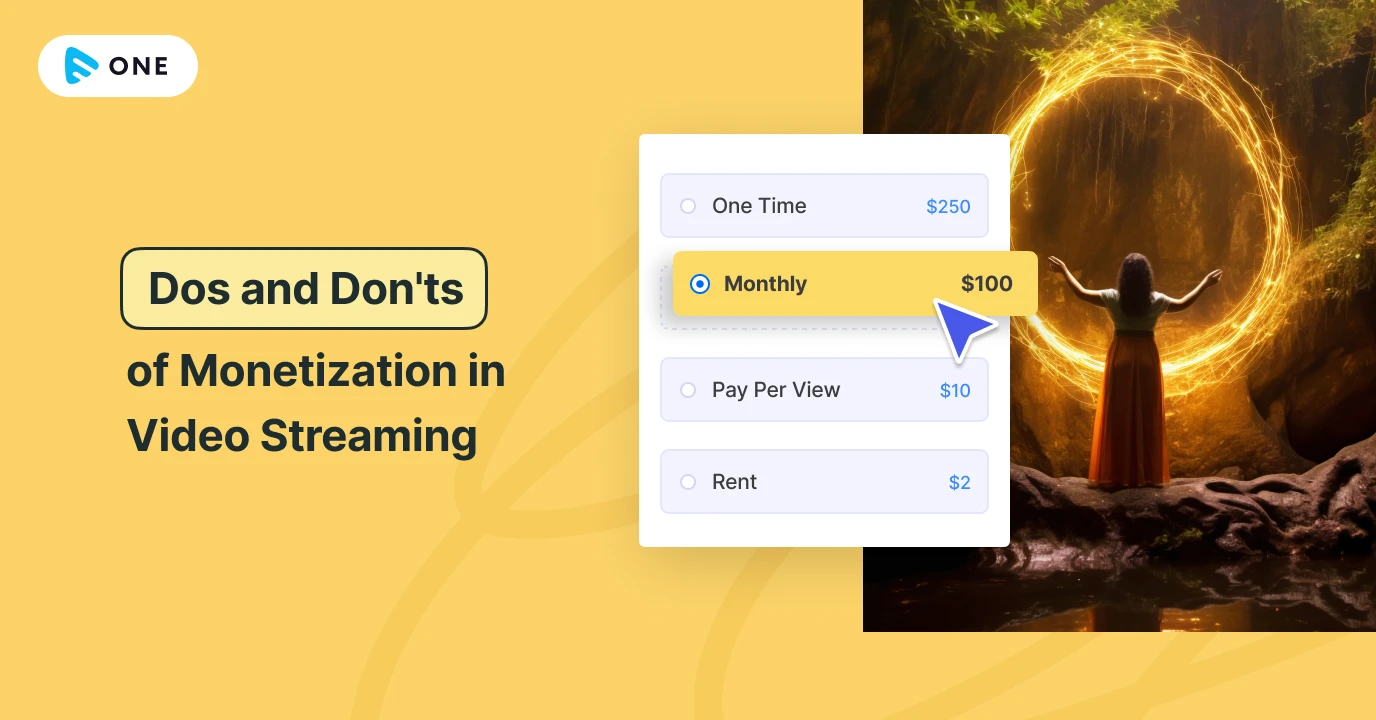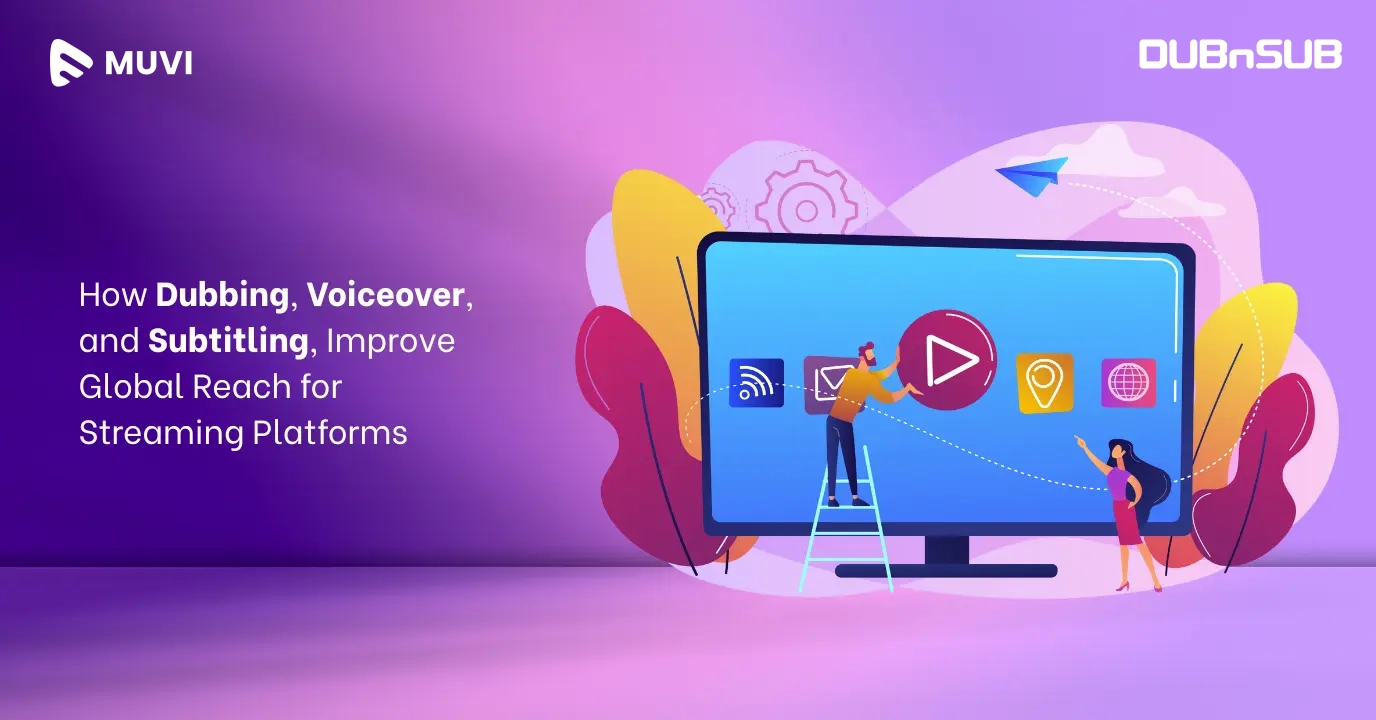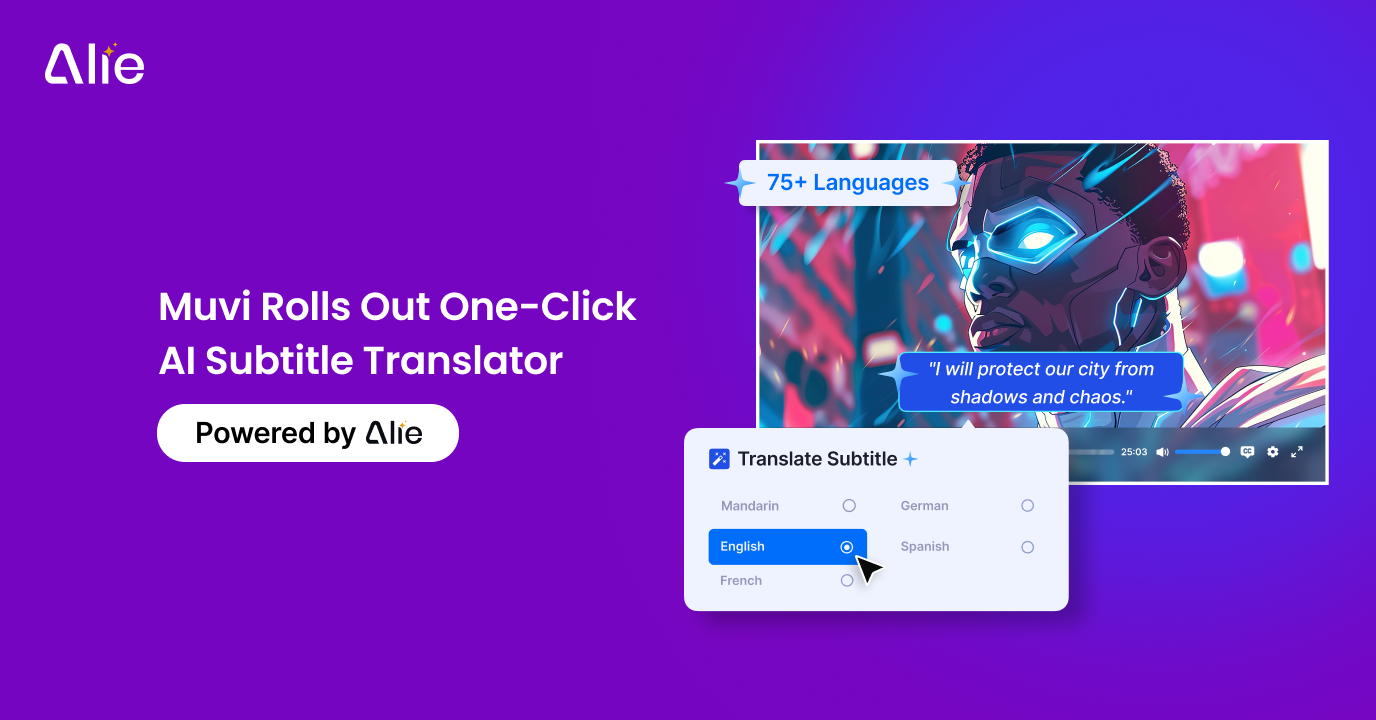Amidst the spiking digital content consumption, video monetization has become a pivotal aspect of success for video streaming businesses. The ability to generate revenue through online video streaming not only sustains businesses but also fuels the growth and innovation of the streaming industry.
As audiences increasingly shift towards online platforms for entertainment, understanding the dos and don’ts of video monetization is paramount for those looking to thrive in this competitive industry. Monetization, in the context of streaming, goes beyond mere financial gain; it is a strategic imperative that can make or break a streaming business.
It involves exploring a complex terrain of advertising, subscription models, sponsorships, and more. Knowing what to do and what to avoid is not just about financial gain; it’s about building a sustainable and ethical business model. And in this blog, we will walk you through all you need to know about it. So, let’s get started!
The Significance of Video Monetization in Streaming
The significance of video monetization lies in its transformative power to convert creative endeavors into sustainable businesses. As audiences increasingly gravitate toward digital platforms, the ability to effectively monetize video content becomes imperative.
Beyond mere financial gain, successful video monetization strategies empower businesses to produce high-quality content consistently, fostering innovation and diversity in the streaming landscape.
For streaming platforms, it is a means to thrive economically and invest in technological advancements, thus enhancing the overall user experience. Furthermore, the significance extends to the viewers themselves, as strategic monetization ensures a balanced and non-intrusive integration of ads or subscription models, contributing to a positive and enjoyable content-consumption experience.
Video monetization in streaming is not merely a transactional process; it is a fundamental force shaping the present and future of digital entertainment, creating a symbiotic relationship between businesses, platforms, and audiences that fuels the continual evolution and growth of the streaming industry.
What are the Dos and Don’ts of Video Monetization in Streaming?
Don’ts of Video Monetization in Streaming
1. Opaque Subscription Terms
One of the critical pitfalls in video streaming is the adoption of opaque subscription terms. When platforms fail to communicate subscription details clearly and concisely, it can lead to confusion and frustration among users. Hidden fees, unclear cancellation policies, or automatic renewals without explicit consent can result in a loss of trust.
Users should have a comprehensive understanding of what they are paying for, the terms of their subscription, and how to cancel or modify their plan. Platforms that prioritize transparency in subscription terms not only build trust with their audience but also reduce the likelihood of customer complaints and dissatisfaction.
2. Intrusive Advertisements
One of the common mistakes in video monetization is the use of intrusive advertisements. When ads disrupt the natural flow of content or impede the viewing experience, it can lead to viewer frustration and dissatisfaction. Intrusive ads, such as those that pop up unexpectedly, cover a significant portion of the screen, or interrupt content abruptly, can drive users away.
Streaming platforms should prioritize non-disruptive ad placements that seamlessly integrate with the viewing experience. By respecting the viewer’s time and engagement, platforms can strike a balance between revenue generation and user satisfaction.
3. Excessive Ad Overload
While ads are an essential revenue stream, bombarding viewers with an excessive number of ads in a single session can result in ad fatigue and diminish the overall viewing experience. The temptation to maximize ad revenue must be tempered with a consideration for user engagement.
Excessive ad overload not only disrupts content enjoyment but also risks pushing viewers to explore ad-free alternatives or, worse, abandoning the platform altogether. Striking a balance in ad frequency and duration is crucial to maintaining viewer retention and preventing a negative perception of the streaming service.
4. Low-Quality Content Focus
Monetizing through video content should not come at the expense of content quality. Focusing solely on quantity over quality can erode the trust and loyalty of viewers. A strategy centered on churning out low-quality content with the sole purpose of maximizing ad impressions can backfire, as viewers increasingly value premium and engaging content.
Streaming platforms should prioritize a balanced approach, ensuring that monetization efforts align with the creation and promotion of high-quality content. Ultimately, viewer satisfaction and long-term retention are closely tied to the perceived value of the content being offered.
5. Neglecting Viewer Engagement
A common mistake in video streaming is neglecting viewer engagement in pursuit of monetization goals. A platform’s success is not solely determined by the number of subscribers but also by the level of engagement and interaction with the audience. Ignoring the importance of fostering a sense of community, responding to user feedback, or enhancing user experience can result in a decline in viewer loyalty.
Platforms should actively seek ways to engage viewers, such as through interactive features, community forums, or personalized recommendations. Neglecting viewer engagement not only hinders the platform’s ability to retain users but also limits opportunities for targeted advertising and the creation of a vibrant and loyal user base.
6. Unethical Data Practices
Unethical data practices present a significant risk to video streaming platforms. The improper collection, use, or sharing of user data can lead to privacy concerns and erode user trust. Practices such as selling user data to third parties without consent, invasive tracking methods, or failing to secure user information adequately can result in reputational damage and legal consequences.
Ethical data practices involve transparent data collection policies, obtaining explicit user consent, and safeguarding user information. Platforms should prioritize user privacy, clearly communicate how data is collected and utilized, and adhere to data protection regulations. Respecting user privacy not only aligns with ethical standards but also establishes a foundation of trust that is essential for maintaining a loyal user base.
7. Limited Payment Options
Limited payment options can be a significant hurdle in reaching a diverse and global audience. Platforms that restrict payment methods may alienate potential subscribers who prefer alternative options or who reside in regions where conventional payment methods are less prevalent.
Diversifying payment options to include digital wallets, local payment gateways, and alternative currencies can enhance accessibility and cater to a broader user base.
8. Ignoring Potential Partnerships
Overlooking the potential of strategic partnerships is a missed opportunity for streaming platforms. Collaborations with businesses, other streaming services, or even non-traditional partners can unlock synergies that benefit both parties.
Neglecting partnerships limits the platform’s ability to diversify content offerings, expand its audience reach, and explore innovative monetization avenues.
9. Rigid Pricing Models
Rigid pricing models can impede a streaming platform’s ability to cater to the diverse preferences and financial capacities of its audience. Offering flexible pricing tiers with varying features or subscription durations provides users with options that align with their needs. A one-size-fits-all approach may result in missed opportunities to capture different segments of the market.
10. Static Monetization Strategies
Maintaining static monetization strategies in the rapidly evolving streaming landscape is a recipe for stagnation. Platforms that do not regularly reassess and adapt their monetization strategies risk falling behind competitors and failing to capitalize on emerging trends.
Dynamism is crucial in responding to shifts in user behavior, technological advancements, and industry developments.
Dos of Video Monetization in Streaming
1. User-Friendly Ads Integration
The integration of advertisements is a key component of video monetization, but it must be executed thoughtfully to avoid disrupting the user experience. Successful streaming platforms prioritize user-friendly ads integration by seamlessly incorporating ads into the content flow.
A prime example of this is YouTube, which strategically places non-intrusive ads before or during videos. By ensuring that ads are relevant and seamlessly integrated, platforms can maximize revenue without alienating viewers. This approach respects the audience’s time and attention, fostering a positive relationship between businesses, advertisers, and viewers.
2. Balanced Ad Frequency
While ads are a crucial revenue source, bombarding viewers with an excessive number of ads can lead to frustration and disengagement. The key is to strike a balance in ad frequency, respecting the viewer’s time and attention.
Streaming platforms like Hulu exemplify this by offering different subscription tiers with varying ad loads. Users can opt for an ad-supported plan at a lower cost or choose an ad-free experience at a higher price.
This flexibility allows platforms to cater to diverse viewer preferences while optimizing revenue streams. The emphasis on balanced ad frequency not only enhances the viewer experience but also encourages user retention and satisfaction.
3. Quality Content Priority
One of the fundamental principles of successful video monetization is placing a premium on quality content. Viewers are more likely to tolerate ads if they perceive the content as valuable and engaging.
Streaming platforms that prioritize quality content, such as Netflix and Disney+, attract and retain subscribers based on the strength of their original programming. By investing in compelling and diverse content, platforms can justify their monetization strategies and build a loyal audience. Quality content not only attracts advertisers seeking premium placements but also establishes the platform as a go-to destination for viewers, creating a win-win scenario for all stakeholders.
4. Transparent Subscription Models
Transparent subscription models are pivotal for viewer trust and satisfaction in the streaming industry. Platforms that openly communicate their pricing structures, benefits, and any limitations create a transparent and honest relationship with their audience.
An exemplary model can be found in Amazon Prime Video, which not only provides a clear breakdown of its subscription plans but also offers additional perks like free shipping and access to a variety of services beyond video streaming.
This level of transparency builds trust, reduces subscription churn, and allows viewers to make informed decisions about their investment in a streaming service.
5. Consistent Viewer Engagement
Consistent viewer engagement is a fundamental aspect of video monetization, as it directly impacts user retention and satisfaction. Successful streaming platforms understand the importance of fostering an ongoing connection with their audience.
YouTube, for instance, employs algorithms that recommend content tailored to individual user preferences, keeping viewers engaged and encouraging prolonged sessions. By consistently delivering personalized and relevant content, streaming platforms enhance viewer loyalty and increase the likelihood of users remaining subscribed over the long term.
6. Respectful Data Collection Practices
Respecting user privacy and implementing ethical data collection practices is imperative in an era where concerns about data security and privacy are at the forefront. Streaming platforms that prioritize user privacy, like Apple TV+, exemplify a commitment to respectful data collection.
Apple TV+ distinguishes itself by not relying on user data for targeted advertising, providing a privacy-focused alternative in an industry where data-driven advertising is prevalent. By assuring users that their data is handled with the utmost care and transparency, streaming platforms can build trust and create a positive environment for both businesses and viewers.
7. Localized Payment Options
Embracing localized payment options is a pivotal step in catering to a global audience with varied payment preferences and methods. Streaming platforms that adapt to regional payment norms demonstrate a commitment to inclusivity and accessibility. Netflix, a global streaming giant, employs a localized payment strategy by offering a variety of payment methods based on regional preferences.
In India, for example, Netflix accepts payments through local digital wallets, catering to the country’s widespread use of these services. By aligning payment options with local habits, streaming platforms not only remove barriers to entry but also create a seamless and user-friendly payment experience for subscribers around the world.
8. Strategic Partner Collaborations
Strategic collaborations with partners can significantly amplify the monetization potential of video streaming platforms. By joining forces with complementary brands or businesses, platforms can unlock new revenue streams, enhance content offerings, and create unique value propositions.
A noteworthy example is the collaboration between Disney+ and Verizon in the United States. Verizon offers its customers free access to Disney+ as part of certain wireless plans, creating a mutually beneficial partnership.
This collaboration not only expands Disney+’s subscriber base but also provides Verizon customers with added value, fostering customer loyalty. Strategic partnerships like these leverage the strengths of each party, resulting in a win-win scenario that goes beyond conventional subscription revenue.
9. Adaptive Pricing Structures
Adaptive pricing structures empower streaming platforms to cater to diverse audience segments with varying preferences and financial capacities. Offering tiered pricing plans with different features or levels of access allows platforms to appeal to a broader demographic.
Spotify, a music streaming service that also integrates video content, exemplifies this approach with its free, ad-supported tier, and premium subscription options. The adaptive pricing structure caters to users who are willing to endure ads in exchange for free access and those who prefer an ad-free experience by subscribing to premium plans.
This flexibility not only maximizes revenue potential but also accommodates a wide range of user preferences, contributing to sustained growth and user satisfaction.
10. Regular Monetization Assessments
Regular monetization assessments are integral to the sustained success of video streaming platforms in an ever-changing digital landscape. As the dynamics of user behavior, market trends, and technological advancements evolve, periodic evaluations of monetization strategies ensure platforms remain agile and responsive to emerging opportunities. Streaming services that prioritize regular assessments can adapt their monetization models, optimize revenue streams, and enhance the overall viewer experience.
An exemplary case of regular monetization assessments is observed in the strategies employed by YouTube. YouTube continually evaluates and refines its monetization features, such as advertising formats, revenue-sharing models for businesses, and subscription offerings.
The platform regularly introduces updates and innovations based on user feedback and industry trends. This commitment to ongoing assessment has enabled YouTube to maintain its strong position in the competitive industry.
To Conclude
Undoubtedly, by navigating the dos and don’ts of video monetization, platforms can strike a delicate balance between maximizing revenue and ensuring a positive viewer experience. From embracing user-friendly ads integration to fostering consistent viewer engagement and respecting ethical data practices, these strategies collectively contribute to the long-term success of streaming ventures.
For those looking to effortlessly launch and optimize their own branded OTT platform, Muvi One emerges as an all-in-one solution. With just a few button clicks, Muvi One allows you to launch your own customized streaming platform, providing a seamless experience for both businesses and viewers.
Its comprehensive features not only facilitate the creation of a unique streaming platform but also offer robust tools for effective video monetization. Muvi One’s capabilities empower businesses to not only enter the OTT space effortlessly but also to reach their video monetization goals with efficiency and effectiveness.
Still wondering? Take a 14-day free trial today!

















Add your comment